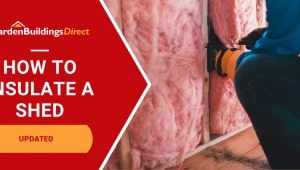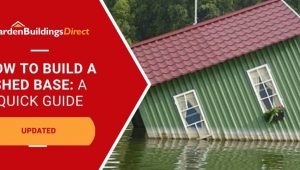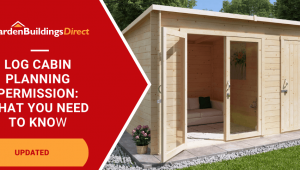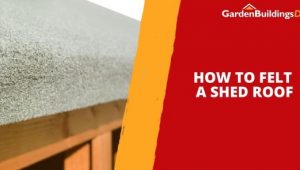Jump to:
What happens under your shed is as important as what goes on top. Shed airflow underneath makes the difference between a dry floor and one that rots out too soon. Here’s what you need to know, including some ways to do it.
If you’re still deciding which type of shed is right for your garden, our shed buying guide covers all the key considerations from materials to bases.
Does a Shed Need Ventilation Underneath?
Yes, sheds do need ventilation underneath. Without it, moisture rises up under the floor and seeps into the inside of your shed. The impact this has depends on the material.
For wooden sheds, rising damp can cause rot in the floorboards and walls. While pressure treatment provides some resistance to this, it is not effective against prolonged wetness that fails to dry.
In the case of metal and plastic sheds, collecting moisture inside can lead to mould growth on the walls and ceiling. While this won’t necessarily cause damage to the structure of metal or plastic, it makes the shed unsafe for people to be inside and can also damage items stored in it.
Shed bases that provide the most airflow
How much airflow you get and how you achieve it depend on the type of shed base you use. For instance, a timber frame already has open gaps. Air can pass through without you needing to do more.
A concrete slab or paving slabs are different. They’re solid and flat, so if you sit the shed floor directly on top, there’s nowhere for moisture to escape. That’s why bearers are fitted as standard in most of our wooden shed units. They raise the structure by at least 28mm, which is enough to let air circulate underneath and keep the floor dry.
If you know your garden is prone to pooling water, you might want to raise the shed even higher. You can add extra spacers, timber blocks, or adjustable supports to do so. This improves ventilation, but don’t go too far, as a gap that’s too big can let animals nest underneath!
Regardless of which type of base you choose, leave plenty of space around the shed! The air gaps will be ineffective if you block them by putting your shed up against a wall or fence, or storing items along the edge. At least 2 feet of space around all four sides is a requirement of our guarantee on wooden sheds.
Using Bricks or Stilts to Let Airflow Underneath Your Shed
Bricks and stilts are sometimes used to lift a shed, and they do give airflow. The big but is that there are things to consider before going down this route.
The main one is balance. A shed needs to sit level and steady. If the bricks or stilts aren’t spaced in equal positions, the weight of the shed won’t be supported in the right way. That can twist the frame or make the doors stick over time.
Another issue is the size of the gap. Cats, foxes, hedgehogs, and rats can turn the underside of a shed into a nest if there’s enough space. Once they’re in, it’s hard to get them out without lifting the shed again.
Keep the gap modest if you do want to use bricks or supports. We recommend at least no more than a few centimetres higher than standard bearers. Close off the sides with mesh or boarding to still let airflow in.
This method suits uneven ground, but it takes more care than using bases or bearers.
Damp Proof Membrane and Vents in Sheds
A damp-proof membrane is a sheet that sits between the ground and the shed base. Its job is to block moisture rising from the soil and reaching the floor. Vents, in contrast, don’t stop ground moisture. Instead, they let stale air out and fresh air in, which keeps condensation from building up inside.
Some sheds already come with vents, but if yours doesn’t, it’s easy to add them. Plastic or metal grilles can be fitted near the roof line or along the walls.
But using both a membrane and vent covers you from two sides:
- One stops damp coming up from the ground
- The other controls the moisture that forms inside
Used together, they keep the shed dry and protect what’s inside.
That doesn’t mean ventilation isn’t needed. Instead, your focus is on the wall or roof vents. Many sheds made from these materials come with them, but if yours doesn’t, you can add a few.
Check out this guide to learn more: Shed Ventilation: How-to and Things to Consider
Not bought your shed yet? Check out our complete shed range.
For low maintenance, ventilated metal sheds and plastic sheds are your ideal storage solution.





